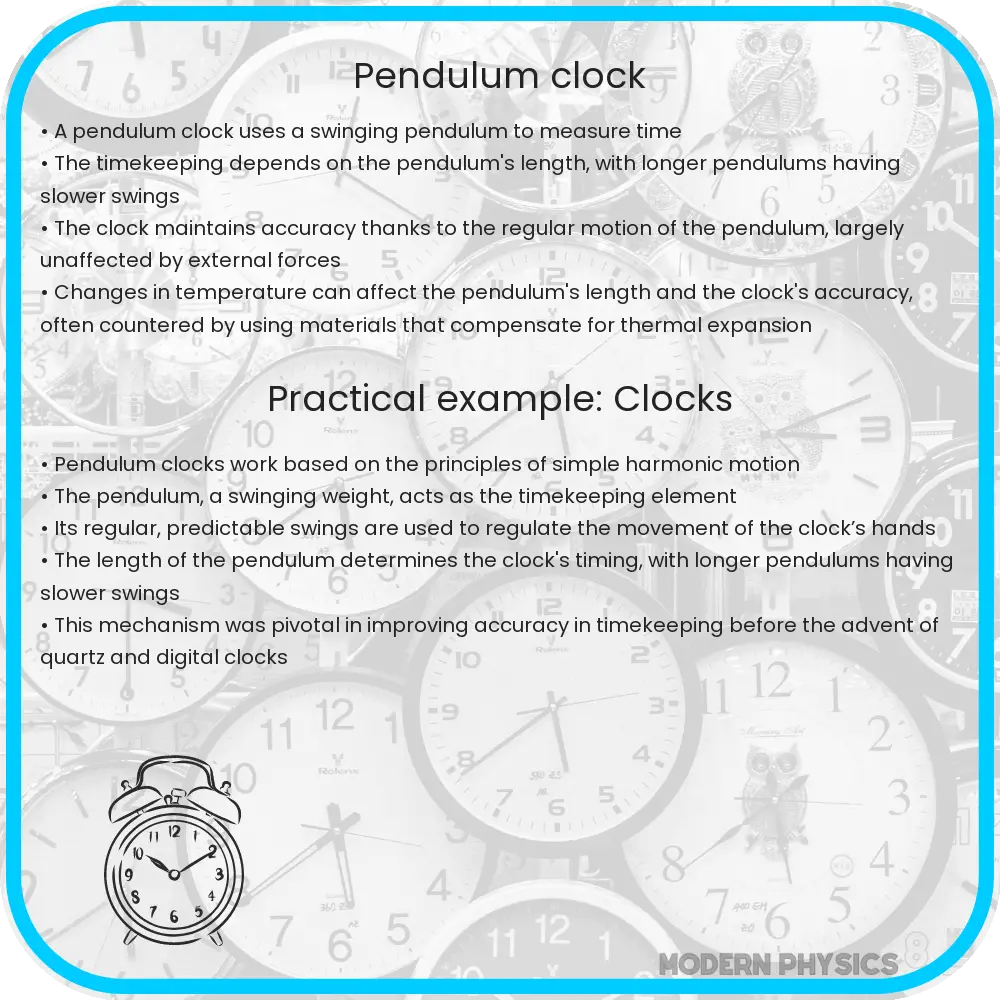Explore the precision and mechanics of pendulum clocks, from their historical significance to modern relevance in this detailed and engaging article.

Pendulum Clocks: Unraveling the Art of Precision and Mechanics
The pendulum clock, a masterpiece of precision and mechanics, has captivated the minds of horologists and enthusiasts alike for centuries. Invented in 1656 by Christiaan Huygens, a Dutch scientist, the pendulum clock brought about a revolution in timekeeping accuracy. This article delves into the intricate world of pendulum clocks, exploring their design, operation, and the principles of motion that govern them.
Understanding the Pendulum Mechanism
At the heart of a pendulum clock is the pendulum itself, a weight suspended from a pivot that swings back and forth. The pendulum’s periodic motion is what drives the clock’s timekeeping mechanism. The length of the pendulum directly influences its oscillation period, as described by the formula:
\[ T = 2\pi\sqrt{\frac{L}{g}} \]
where \( T \) is the period of oscillation, \( L \) is the length of the pendulum, and \( g \) is the acceleration due to gravity. This relationship underscores the importance of precision in the pendulum’s length for accurate timekeeping.
The Escapement Mechanism
Integral to the pendulum clock is the escapement mechanism, which regulates the transfer of energy to the clock’s gear train and ensures the pendulum’s consistent motion. The escapement does this by interlocking with a gear wheel, releasing one tooth of the wheel with each swing of the pendulum. This process not only drives the clock’s hands but also gives the pendulum a slight push to maintain its motion.
Crafting for Precision
The accuracy of a pendulum clock is greatly affected by environmental factors like temperature and humidity. Metals, which make up most of the clock’s internal components, expand and contract with temperature changes. This can alter the length of the pendulum, affecting the clock’s accuracy. To mitigate this, clockmakers have developed ingenious solutions such as using invar, a type of steel alloy with minimal thermal expansion, and creating temperature-compensated pendulums.
Furthermore, the precision in crafting each gear and wheel in the clock’s mechanism is crucial. Even the slightest imperfection can lead to significant timekeeping errors. This meticulous attention to detail is what sets high-quality pendulum clocks apart from their counterparts.
The Aesthetics of Motion
Beyond their technical brilliance, pendulum clocks are also celebrated for their aesthetic beauty. The rhythmic motion of the pendulum and the intricate craftsmanship of the clockwork create a mesmerizing visual and auditory experience. From elaborate grandfather clocks to minimalist timepieces, the design of pendulum clocks has evolved, reflecting changes in artistic tastes and technological advancements.
In the next section, we will explore the historical significance of pendulum clocks, their impact on science and navigation, and the ongoing fascination they hold in an era dominated by digital technology.
The Historical Impact of Pendulum Clocks
Pendulum clocks have played a pivotal role in history, particularly in the scientific revolution and the advancement of timekeeping. In the 17th and 18th centuries, these clocks were instrumental in astronomical observations, enabling astronomers to measure time with unprecedented accuracy. This precision was crucial for mapping the stars and contributed significantly to the development of celestial navigation, aiding sea voyagers in determining longitude at sea.
Legacy in Modern Timekeeping
Although modern quartz and atomic clocks have surpassed pendulum clocks in accuracy, the principles discovered through the development of pendulum clocks laid the foundation for these advancements. The pursuit of precision in pendulum clocks spearheaded the development of more accurate timekeeping technologies, leading to the highly precise atomic clocks we rely on today for global positioning systems (GPS) and international time standards.
Continued Fascination and Contemporary Relevance
In an age dominated by digital technology, pendulum clocks continue to hold a special place. Their mechanical operation, free from the need for electricity or batteries, speaks to a sustainable, enduring method of timekeeping. Additionally, the charm and elegance of pendulum clocks make them coveted items for collectors and enthusiasts, appreciated not just for their functionality but also for their artistic and historical value.
Preserving a Time-Honored Tradition
The art of crafting pendulum clocks is preserved by skilled horologists and clockmakers who continue to build and maintain these timepieces. This tradition upholds not just a craft but also a rich history of scientific inquiry and mechanical ingenuity. Museums and collectors play a crucial role in conserving antique pendulum clocks, ensuring that future generations can appreciate their legacy.
Conclusion
In conclusion, the pendulum clock stands as a testament to the human quest for precision and understanding of the natural world. From its inception in the 17th century to its ongoing appeal in the modern era, the pendulum clock encapsulates a blend of art, science, and history. It reminds us of the continuous evolution of timekeeping methods and the relentless human pursuit to measure and understand time more accurately. As we embrace digital technologies, the pendulum clock remains a symbol of the enduring beauty and ingenuity of mechanical timekeeping, a legacy that continues to tick through the annals of history.
